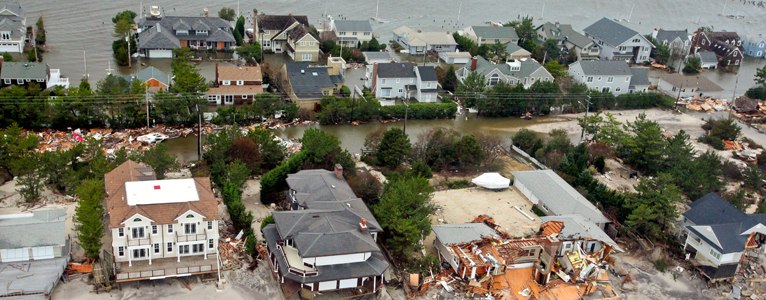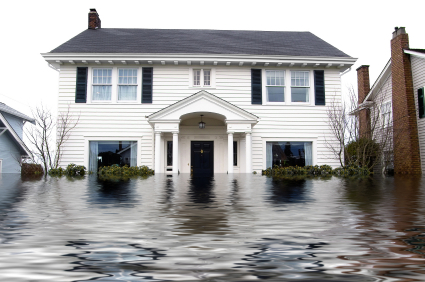
It is well known that every state in the U.S. experiences flooding or some sort of flash flood. For homeowners or renters, this means that you don’t necessarily have to live near a body of water to be exposed to the dangers of flooding. Heavy rains, a sudden thunderstorm or melting snow from mountains hundreds of mile away can be enough to cause flooding in the most unexpected places.
The Midwest typically experiences river flooding, the Northeast can suffer Nor’easters and spring melting, and the West Coast usually is known for flooding from November through March. Flash floods are known to cause a wall of water anywhere from 10 to 20 feet high. All it takes is a few inches of water from a flood to cause thousands of dollars in damage. If you’re a homeowner, the purchase of flood insurance is mandatory if the property is located in a high-risk flood area. Some lenders can even require flood insurance if you live in an area with a low-risk of flooding.
Floods are the number 1 disaster in the U.S.
Most people don’t realize that floods are the number one disaster in the United States. According to the Federal Emergency Management Agency (FEMA), the average flood claim from 2008 to 2012 was $42,000. In 2012 the average flood insurance policy cost $650 per year. In 2014, the average amount of claims paid ranged from $10,476 to $42,275. Flood insurance rates in 2015 are predicted to rise by as much as 18%.
The 2015 Hurricane season doesn’t start until June 1st. Although they are predicting a calmer season this year, heavy rains across the Midwest and South are already causing flooding issues. Here are 5 things you should know about flood insurance and preparing for flooding disasters.
1) Identifying flood risk areas
Flood hazard areas are recognized by the National Flood Insurance Program (NFIP) as one of three specific areas. Special Flood Hazard Areas (SFHA) are characterized as areas that have a 1% chance of being inundated by a flood event in any given year. The 1% chance is often referred to as the 100-year flood or as the base flood.
Zoning for SFHA’s are labeled as: Zone A, Zone AO, Zone AH, Zones A1-A30, Zone AE, Zone A99, Zone AR, Zone AR/AE, Zone AR/AO, Zone AR/A1-A30, Zone AR/A, Zone V, Zone VE, and Zones V1-V30.
Moderate flood zones fall within the 500-year flood zone or have a 0.2% chance of flooding and are labeled as Zone B or Zone X.
Minimal flood hazard zones are regions higher than 0.2% elevation and are identified as Zone C or Zone X.
According to lenders, residents who live in high-risk flood areas have a 1 in 4 chance of flooding during the term of a 30-year mortgage. The NFIP created the Flood Insurance Rate Map (FIRM) that identifies the flood hazards for communities. FIRM has a step by step guide for homeowners to help them identify the flood risk for their property.
2) What is covered by flood insurance?
 Flood insurance will cover both the building and the contents inside, however it does not cover the land on which the premises is located. Limited coverage for basements, crawlspaces, lower floors and enclosed floors of raised buildings is not uncommon.
Flood insurance will cover both the building and the contents inside, however it does not cover the land on which the premises is located. Limited coverage for basements, crawlspaces, lower floors and enclosed floors of raised buildings is not uncommon.
Dwelling coverage will cover property up to $250,000 and contents coverage insures up to $100,000 of personal property. The NFIP encourages customers to purchase both types of coverage since homeowners insurance will not cover losses related to flooding. Flood insurance is not a valued policy and does not pay more than the policy limit for any losses.
Building coverage covers:
- The building and its foundation
- The electrical and pluming systems
- Major systems like central air conditioning, furnaces, and hot water heaters
- Certain appliances such as stoves, refrigerators, and dishwashers
- Permanently installed carpeting over an unfinished floor (wood, cement, etc.)
- Window blinds
- Detached garage (up to 10% of building property coverage)
Coverage for contents includes:
- Clothing, furniture and electronic equipment
- Portable window air conditioners
- Portable appliances such as microwaves and dishwashers
- Carpeting that is not covered under the building coverage
- Clothes washers & dryers
- Freezers and the food inside
- Certain valuable items such as artwork & furs (up to $2,500)
3) What is not covered?
There are a number of damages and expenses a flood insurance policy will not cover. These include:
- Damage caused by moisture, mildew or mold that could have been prevented
- Currency, precious metals, and valuable papers
- Property and items outside of the dwelling such as trees, plants, wells, septic systems, walkways, decks, patios, fences, hot tubs, seawalls and swimming pools
- Financial losses due to business interruption or loss of use of the insured property
- Most self-propelled vehicles
4) Who should be insured?
Anyone who owns a home near a body of water, including lakes and streams, should buy a flood insurance policy to protect their property. Policies are available for individuals who live in high risk flood areas, even if the land has been flooded before.
A number of factors will affect the rates such as the type of building, contents, whether or not the property has a basement, if all of the contents are located above ground level, the building construction, the property’s elevation and where the physical property is located (in a high-risk or low-risk area).
5) Preparation Tips
While most incidents where flooding is a possibility will come with some warning, there are steps that homeowners can take to prepare their properties well before an event occurs.
Start with an inspection of inside and outside spaces:
- Ensure gutters and downspouts are clear of debris and drain away from the structure.
- Remove any damaged or low-hanging branches. Landscaping should not allow water to collect next to the foundation of the building.
- Check low-lying areas that are vulnerable to water and check that they drain away from any basements or foundations.
- Walk through the basement to see what furniture, photos, electronics or other contents could be compromised or damaged during any flooding, and move them to a higher location or place them in protective, waterproof containers.
- Do a full inventory of the home and contents. A good tip is to go room by room with a video camera and take photos with a digital camera. This provides a quick inventory of collectibles, works of art, antiques and other irreplaceable items.
Paperwork and preparations:
- Collect insurance policies pertaining to the home and be familiar with what they do and do not cover.
- Ask your insurance agent to do a review of policy limits and exclusions so you know what’s covered.
- Prepare supplies in case of a power outage– stock up on essentials like batteries, bottled water, canned goods, flashlights, etc.
- Have a checklist of items to grab if you only have seconds to prepare – e.g., purse, phone, laptop, medications.
Taking these steps ahead of time, preparing for a variety of disasters and thinking through what to do and where to go will help save precious time if an unexpected emergency or disaster does occur. Reviewing insurance coverages and reducing the risk where possible will also make the recovery a little easier.
If you have any questions about flood insurance coverage, our flood insurance experts are ready to help you.

Sources: propertycasualty360.com “5 things you should know about flood insurance“, fema.org “FEMA Website“
